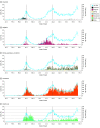Transmission of COVID-19 in Nightlife, Household, and Health Care Settings in Tokyo, Japan, in 2020
- PMID: 36826818
- PMCID: PMC9958531
- DOI: 10.1001/jamanetworkopen.2023.0589
Transmission of COVID-19 in Nightlife, Household, and Health Care Settings in Tokyo, Japan, in 2020
Abstract
Importance: There have been few studies on the heterogeneous interconnection of COVID-19 outbreaks occurring in different social settings using robust, surveillance epidemiological data.
Objectives: To describe the characteristics of COVID-19 transmission within different social settings and to evaluate settings associated with onward transmission to other settings.
Design, setting, and participants: This is a case series study of laboratory-confirmed COVID-19 cases in Tokyo between January 23 and December 5, 2020, when vaccination was not yet implemented. Using epidemiological investigation data collected by public health centers, epidemiological links were identified and classified into 7 transmission settings: imported, nightlife, dining, workplace, household, health care, and other.
Main outcomes and measures: The number of cases per setting and the likelihood of generating onward transmissions were compared between different transmission settings.
Results: Of the 44 054 confirmed COVID-19 cases in this study, 25 241 (57.3%) were among male patients, and the median (IQR) age of patients was 36 (26-52) years. Transmission settings were identified in 13 122 cases, including 6768 household, 2733 health care, and 1174 nightlife cases. More than 6600 transmission settings were detected, and nightlife (72 of 380 [18.9%]; P < .001) and health care (119 [36.2%]; P < .001) settings were more likely to involve 5 or more cases than dining, workplace, household, and other settings. Nightlife cases appeared in the earlier phase of the epidemic, while household and health care cases appeared later. After adjustment for transmission setting, sex, age group, presence of symptoms, and wave, household and health care cases were less likely to generate onward transmission compared with nightlife cases (household: adjusted odds ratio, 0.03; 95% CI, 0.02-0.05; health care: adjusted odds ratio, 0.57; 95% CI, 0.41-0.79). Household settings were associated with intergenerational transmission, while nonhousehold settings mainly comprised transmission between the same age group. Among 30 932 cases without identified transmission settings, cases with a history of visiting nightlife establishments were more likely to generate onward transmission to nonhousehold settings (adjusted odds ratio, 5.30 [95% CI, 4.64-6.05]; P < .001) than those without such history.
Conclusions and relevance: In this case series study, COVID-19 cases identified in nightlife settings were associated with a higher likelihood of spreading COVID-19 than household and health care cases. Surveillance and interventions targeting nightlife settings should be prioritized to disrupt COVID-19 transmission, especially in the early stage of an epidemic.
Conflict of interest statement
Figures



Similar articles
-
Epidemiological analysis of 3,219 COVID-19 outbreaks in the state of Baden-Wuerttemberg, Germany.Epidemiol Infect. 2021 Apr 23;149:e101. doi: 10.1017/S0950268821000911. Epidemiol Infect. 2021. PMID: 33888172 Free PMC article.
-
An Analysis of Factors Contributing to Household Transmission of COVID-19 Using Data from Active Epidemiological Investigations Performed in the Setagaya Ward of Tokyo, Japan.Jpn J Infect Dis. 2024 Nov 21;77(6):317-324. doi: 10.7883/yoken.JJID.2023.342. Epub 2024 Jun 28. Jpn J Infect Dis. 2024. PMID: 38945861
-
Contact Tracing Assessment of COVID-19 Transmission Dynamics in Taiwan and Risk at Different Exposure Periods Before and After Symptom Onset.JAMA Intern Med. 2020 Sep 1;180(9):1156-1163. doi: 10.1001/jamainternmed.2020.2020. JAMA Intern Med. 2020. PMID: 32356867 Free PMC article.
-
Effectiveness and cost-effectiveness of four different strategies for SARS-CoV-2 surveillance in the general population (CoV-Surv Study): a structured summary of a study protocol for a cluster-randomised, two-factorial controlled trial.Trials. 2021 Jan 8;22(1):39. doi: 10.1186/s13063-020-04982-z. Trials. 2021. PMID: 33419461 Free PMC article.
-
Household transmission of SARS-CoV-2 and risk factors for susceptibility and infectivity in Wuhan: a retrospective observational study.Lancet Infect Dis. 2021 May;21(5):617-628. doi: 10.1016/S1473-3099(20)30981-6. Epub 2021 Jan 18. Lancet Infect Dis. 2021. PMID: 33476567 Free PMC article.
Cited by
-
Variability in the Population Diffusion Patterns of SARS-CoV-2 by Exposure Setting and Its Roles in Driving Epidemic Dynamics.Influenza Other Respir Viruses. 2025 Jun;19(6):e70125. doi: 10.1111/irv.70125. Influenza Other Respir Viruses. 2025. PMID: 40452161 Free PMC article.
-
Population Behavior Changes Underlying Phasic Shifts of SARS-CoV-2 Exposure Settings Across 3 Omicron Epidemic Waves in Hong Kong: Prospective Cohort Study.JMIR Public Health Surveill. 2024 Jun 19;10:e51498. doi: 10.2196/51498. JMIR Public Health Surveill. 2024. PMID: 38896447 Free PMC article.
-
Nightlife and low immunity drove transmission of SARS-CoV-2 gamma in Luxembourg, 2021.Sci Rep. 2025 Mar 25;15(1):10293. doi: 10.1038/s41598-025-94323-4. Sci Rep. 2025. PMID: 40133357 Free PMC article.
-
Indirect and direct effects of nighttime light on COVID-19 mortality using satellite image mapping approach.Sci Rep. 2024 Oct 23;14(1):25063. doi: 10.1038/s41598-024-75484-0. Sci Rep. 2024. PMID: 39443573 Free PMC article.
-
Fukuchi-Manabe Score for Infection Control Measures During the Very Early COVID-19 Pandemic Period When Access to Reverse Transcription-Polymerase Chain Reaction Testing Was Poor in Japan: A Single-Center Observational Prospective Cohort Study.Cureus. 2024 Feb 23;16(2):e54748. doi: 10.7759/cureus.54748. eCollection 2024 Feb. Cureus. 2024. PMID: 38523950 Free PMC article.
References
Publication types
MeSH terms
LinkOut - more resources
Full Text Sources
Medical

